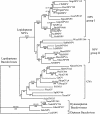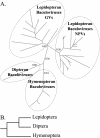Ancient coevolution of baculoviruses and their insect hosts
- PMID: 15016845
- PMCID: PMC371050
- DOI: 10.1128/jvi.78.7.3244-3251.2004
Ancient coevolution of baculoviruses and their insect hosts
Abstract
If the relationships between baculoviruses and their insect hosts are subject to coevolution, this should lead to long-term evolutionary effects such as the specialization of these pathogens for their hosts. To test this hypothesis, a phylogeny of the Baculoviridae, including 39 viruses from hosts of the orders Lepidoptera, Diptera, and Hymenoptera, was reconstructed based on sequences from the genes lef-8 and ac22. The tree showed a clear division of the baculoviruses according to the order of their hosts. This division highlighted the need to reconsider the classification of the baculoviruses to include one or possibly two new genera. Furthermore, the specialization of distinct virus lineages to particular insect orders suggests ancient coevolutionary interactions between baculoviruses and their hosts.
Figures



References
-
- Ahrens, C. H., R. L. Q. Russell, C. J. Funk, J. T. Evans, S. H. Harwood, and G. F. Rohrmann. 1997. The sequence of the Orgyia pseudotsugata multicapsid nuclear polyhedrosis virus genome. Virology 229:381-399. - PubMed
-
- Altschul, S. F., W. Gish, W. Miller, E. W. Myers, and D. J. Lipman. 1990. Basic local alignment search tool. J. Mol. Biol. 215:403-410. - PubMed
-
- Ayres, M. D., S. C. Howard, J. Kuzio, M. Lopez-Ferber, and R. D. Possee. 1994. The complete DNA sequence of Autographa californica nuclear polyhedrosis virus. Virology 202:586-605. - PubMed
-
- Bideshi, D. K., Y. Bigot, and B. A. Federici. 2000. Molecular characterization and phylogenetic analysis of the Harrisina brillians granulovirus granulin gene. Arch. Virol. 145:1933-1945. - PubMed
Publication types
MeSH terms
LinkOut - more resources
Full Text Sources
Other Literature Sources

